Cory Huff's Blog: The Abundant Artist Goodreads blog, page 12
June 4, 2019
Don’t Be a Sucker
Pop quiz: what do P.T. Barnum’s grotesque FeeJee Mermaid and the Enron scandal have in common? Though at vastly different scales and in very different industries, both were scams intended to gently part the innocent and ignorant from their hard earned money. In fact as long as currency has existed, so have scams and scandals looking to make suckers of more honest folks. There isn’t an industry on earth that is free from the clutches of scams and predatory business practices. Unfortunately the art industry is no exception this rule.
Art industry scams are legion in their variety. We can’t cover every possible scam that exists, but our goal here is to cover the basics. In this piece we’ve attempted to provide an overview of common art scams. We also cover a few situations which you may not consider a conventional Nigerian prince scam, but they do tick all the appropriate boxes:
they take advantage of vulnerable artists
they attempt to get something for nothing or for very little
they use the artist’s naivete and hopefulness to their own monetary advantage.
In each section we have provided some examples as well as a breakdown of what makes it a scam, signs to tip you off as you seek to avoid being taken advantage of, and a smarter alternative.
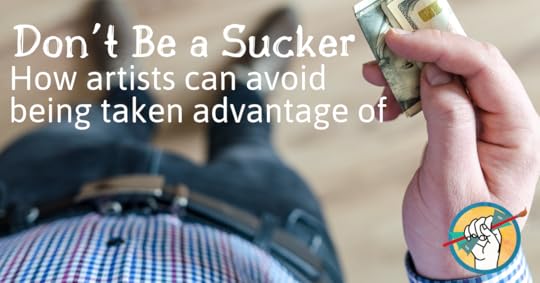
Common email and social media scams
Jennifer has been painting botanicals in watercolor for several years as a hobby. She has given away several pieces for birthdays and holidays, and even sold a few pieces to relatives and close friends. Everyone who sees her work immediately remarks “You should be selling these!” with wide eyes and an encouraging smile (never mind that these people are never the ones who buy anything). She has no clue where to start, but artists who sell their art successfully start with a website, right? She settles on WordPress with Shopify. She creates a Facebook and Instagram page for her burgeoning business, and begins to write a blog.
As her business begins to slowly grow, she begins to receive email inquiries about her work. She can hardly believe her eyes when she receives the following email:
“My name is Daniel Walter from Jacksonvile, Florida. The photos on your website are so fascinating and so amazing, looking at each piece of work i can easily see that you added so much dedicated in making each work come out to life, unfortunately i lost the website where i first saw your work but i was save your email address.
I would like to purchase some of your work for my wife as a surprise gift for our 20th anniversary. Please kindly send images and price of some of your art which are ready for immediate sale between the price range of $500- $5,000, I am flexible with price. I am writing you because i need your help to get back to your website to retrieve the details of your work that interest me or send me images of some of your new work with price.
Best Regards,
Daniel Walters”
At first it seems too good to be true, and for a while Jennifer excitedly sorts through her work to find the best pieces to send to Daniel. Which botanicals are ideal for an anniversary? Roses? Lilacs? Her mind is racing, and she goes back to re-read the email. That’s when it hits her.
Who misspells his own last name? And how exactly does one lose a website? Does he not know how to access his own browser history?
Jennifer’s heart sinks as she realizes that she is being taken for a ride. A quick Google search of the email text pulls up website after website with the same text almost verbatim, sometimes with different names and locations. Had she moved forward, he likely would have sent her a check for two or three times the agreed-upon amount, then ask her to wire the extra back to him.
It probably goes without saying at this point- it’s a scam.
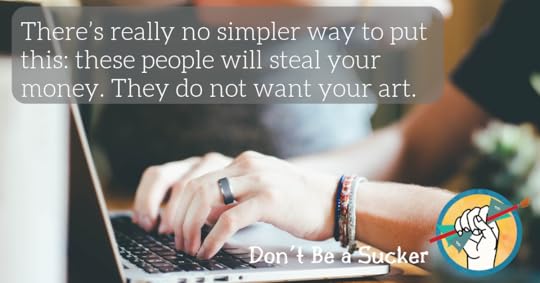
Signs that the email is a scam
First, scammers almost always have terrible grammar and spelling. English is usually not their first language. If you notice inconsistencies in the spelling of the name, email address or location, that’s your first red flag. Consider these other red flags:
Did they “come across your website” or “see their wife looking at your website”?
Despite having supposedly spent some time looking at your work, do they avoid the mention of any specifics in their email?
If they gush over your art, is it in oddly general terms like “I can see you put much dedication in your work”?
They may simply copy/paste the details of a particular piece they profess to be interested in.
When you respond to a scammer like this, they usually request to send you payment via a cashier’s check or similar. They may offer excuses about why they cannot talk on the phone, are often “out of the country on business” or are in the process of moving. They’re often celebrating their spouse’s birthday or an anniversary. They will send you an overpayment, and when you respond to them that they sent too much they will provide a lame excuse and then ask you to send the excess back to them via wire transfer. (Don’t do it.)
For a helpful and ever-growing collection of examples of email scams targeting artists, check out our post How to Recognize the Signs of an Art Scam and visit Stop Art Scams.
Risks of doing business with email scammers
There’s really no simpler way to put this: these people will steal your money. They do not want your art. If you wire back to them the excess of their overpayment, you will soon be notified that the original check bounced or was fake, and you’ll be out that money with no recourse. You will never hear from them again.
If you receive an email and you suspect it’s a scam, do a little research online. Search for other artists’ experiences with the copy of the email, the name of the scammer, etc. You may choose to engage the scammer a little to get more information out of them and see if further red flags pop up, but this isn’t necessary. If you have a bad feeling, delete the email and move on with your life.
Vanity galleries
Feeling annoyed and jaded after several interactions with potential collectors who turned out to be scammers, Jennifer begins to think that the wisest choice may be to sell her art through a gallery. “Let the gallery deal with the scammers,” she thinks, “and I can go back to spending most of my time doing what I love most: painting!”
She starts Google searching galleries in her area. She discovers quickly that this isn’t going to be as simple as she thought. Many of the galleries she comes across are closed to outside submissions, and others simply don’t mesh with her art style. She begins to feel very intimidated and discouraged. In the meantime, she continues working on her website and social media presence and slowly growing her audience.
After a few weeks, something surprising happens! She receives an email from a gallery thirty minutes from her house, and they’re interested in her work! Jennifer is over the moon with excitement. Who knew this would happen so quickly? She exchanges a few emails back and forth, performs a quick Google search, and heads out to meet the owner of the gallery in person.
Everything seems kosher- it’s a real world location in a fairly busy downtown area. The building is well lit and there is art on the walls. As she peruses the art, waiting for her appointment, she feels a bit of a gut check. The portraits on exhibition are surprising. Jennifer knows her art career is still in its early stages, but she can tell quality work when she sees it. This isn’t it. The work on the walls of the gallery isn’t impressionist or primitive. It’s… amateurish. Jennifer swallows hard and tries to convince herself that she’s just being nitpicky because she’s nervous.
When her meeting with the warm and amicable gallery owner begins, the fishy smell intensifies. He gushes over her work to the point of flattery. He then tells her that she can exhibit her work in the gallery for a month along with listings on the gallery’s website, listings in the gallery’s color catalog, and “career guidance” (whatever that means)… all for just $5,000.
Wait, what? Aren’t galleries supposed to help you make money by selling your art for a commission? Jennifer is taken aback at the amount she’s expected to pay up front for the privilege of maybe being able to sell her art through the gallery. She doesn’t have $5,000 to spend up front… she was hoping to make that money by selling her work through a gallery. Assured by the gallery owner that this is not only perfectly legal, but a perfectly normal way to conduct business, she heads home dejected and discouraged.
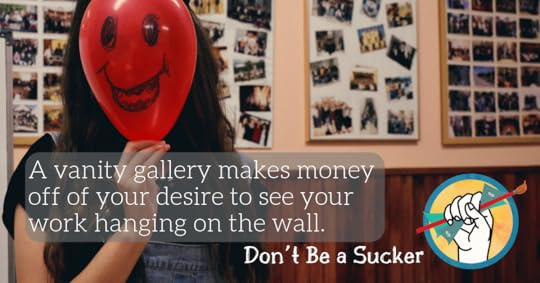
Signs that a gallery is a vanity gallery
Here are a few telltale signs to watch for anytime you’re introduced to a new prospective gallery. Consider carefully the following:
Do they charge a fee in addition to or in place of a regular sales commission?
Do they charge an extra fee for representation services?
Do they charge a fee to be included on their website or in their catalog?
It becomes clear pretty quickly that the distinguishing factor that sets a vanity gallery apart is the fee structure. But why is this so harmful? Conventional galleries charge a pretty significant commission on all sales and can be restrictive with their artists’ online presence and outside sales as well. So why is it so wrong for a vanity gallery to charge a fee?
The key difference between a conventional gallery and a vanity gallery is that a conventional gallery is motivated to sell your work because when you make money, they make money. A vanity gallery makes money off of your desire to see your work hanging on the wall. Is this a scam, per se? Not if the gallery explains their policies clearly up front. Think about it as similar to self-publishing a book versus being published through a traditional publishing house. When you self-publish, you pay up-front for all costs associated with publication, and you must do all of your own marketing. And yes, a few authors do make it big this way. But they are in the minority.
Risks of doing business with a vanity gallery
The first risk of doing business with a vanity gallery is that you won’t make any money. As established above, the gallery makes its money off you. They are far less motivated to do the work of selling. You are going to be responsible for any selling that happens. The unfortunate truth is that an artist who is naive and optimistic enough to pay a vanity gallery is unlikely to have the business skills to sell their work profitably through the gallery.
The second, and perhaps most unfortunate, risk of doing business with a vanity gallery is that it can hurt your reputation and your chances of future success with conventional galleries. Most traditional galleries will be aware of common vanity galleries, and wary of representing artists with a history of showing their work in those spaces. The reason? While not always the case, it’s often true that an artist who pursues a vanity gallery is an artist whose work is not ready for a traditional gallery. Perhaps they haven’t refined their style, they haven’t produced work in a coherent series, or their work simply isn’t good enough yet. When an artist is more concerned with getting their art on the walls of a gallery than with improving and refining their work, it’s a red flag that not only will their work be difficult to sell, but they may also be difficult to work with.
Smarter alternatives to a vanity gallery
A conventional gallery is not the only way to make a good living selling your art. Check out our free resources on how to know if a gallery is the wrong choice for you, and how to succeed without a gallery:
How to Get Your Artwork in Front of Customers Without Relying on a Gallery
Why Artists Should Avoid Gallery Representation
If you’re committed to the gallery model, we have a lot of helpful posts on matching yourself with a good gallery (either on- or off-line) and making the most of the relationship:
Strategies for Gallery Success with Photographer Jeffrey Stone
Selling Your Art Online: Advice From 3 Online Gallery Leaders
How to Get Into a Gallery, and Succeed with a Gallery
Signing with a vanity gallery should never feel like it’s your only option. If you are just now embarking on your art selling journey, check out our free members-only library for a wide range of resources to help you sell your art- without paying someone else to put your art on their walls.
Third party print-on-demand marketplaces
Wisely, Jennifer decides against the vanity gallery. The more she researches the gallery and chats with artist friends, the more she understands that this early in her journey she isn’t really in a position to stake her entire career on paying money she doesn’t have for the chance to do all her own marketing and promotion. She would have to do all of that without the gallery anyway.
Jennifer moves on to researching new options, and that’s when she comes across the print-on-demand marketplace. A relative asks her if she would ever consider putting her designs on throw pillows, which has Jennifer scouring the internet for options. She comes across a large and popular website that will put her art on anything from laptop skins to leggings. Not only that, but she can create her own storefront, and the website will do all the work of creating,selling, and shipping the products! What’s not to love? She thinks this may perhaps be too good to be true.
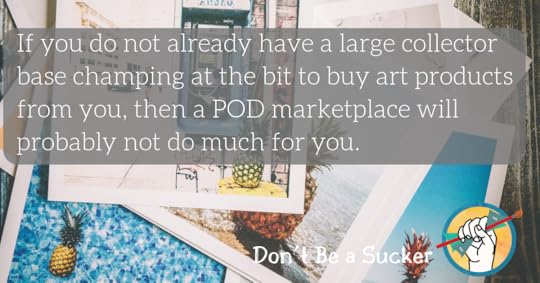
Signs that the print-on-demand marketplace isn’t going to be a lucrative choice for you
A print-on-demand marketplace is not a scam in any traditional sense of the word. But it is a business model that takes advantage of the incredible saturation of artists on the internet looking to make money for minimal effort. If you do not already have a large collector base champing at the bit to buy art products from you, or if you are not interested in putting in a consistently high level of effort over a long period of time, then a POD marketplace will probably not do much for you.
That said, it can be a useful extra income stream, so don’t discount the model entirely. But it’s important to enter in with both eyes wide open, aware that this is not a way to get a big break or get rich quick for the vast majority of artists. There are stories of artists who have found success with print-on-demand marketplaces. Print studio owner Patricia Vargas is one such artist who has found good success with Society6, but it’s worth noting that she was on the platform for quite some time before she got a lucky break, and it is not the only iron she has in the fire. Read our interview with Patricia here: https://theabundantartist.com/podcast28/
Risks of doing business with a print-on-demand marketplace
Unlike a vanity gallery, most print-on-demand marketplaces do not require an up-front fee, though there are a few exceptions. So there is little risk other than the time you’re going to put into a model that is unlikely to produce the return that it seems to promise.
Sizing, formatting, uploading images, pricing, and writing descriptions for the various products available on POD marketplaces can be incredibly time-consuming. This process is not too different from creating the listings to sell art on your own website, but the stark difference is that no one on your own website is going to take a significant percentage of the profit from you. Some POD sites will make a big deal of advertising that artists get to set their own markup. The result is that thousands of artists will list their work at the minimum markup just to attract shoppers looking for a deal, and it will be difficult to compete in the marketplace setting if your prices are higher- even if your work is worth the price.
We did a comprehensive review of the most popular print-on-demand marketplaces including their yearly costs, notable features, processing fees, and much more. To check out the spreadsheet, visit our free member library.
Smarter alternatives to a print-on-demand marketplace
As always, we recommend putting the bulk of your effort into selling on your own website. Why? When you sell on your own website,
You retain 100% of the profit
You retain customer information (many marketplaces don’t provide this information to the artist, robbing them of the opportunity to follow up and develop relationships)
You set your own prices and markup
You retain creative control, and you don’t have to worry about the content or quality of the art your work is displayed alongside.
If your primary concern is the availability of art products that you do not want to create or source yourself, then you may want to consider one of the apps created for Shopify stores, which allow you to integrate the app into your own website and retain all customer information. Some popular choices include Gooten, CGProPrints, and Pixels.com.
Being taken advantage of by family and friends
As Jennifer’s little art business very slowly grows, more and more of her friends and loved ones begin to take notice. She receives a phone call from an aunt who gushes over her work and then suggests that she’d love a print for her den. When Jennifer cheerfully announces the prices of her various prints, her aunt gets evasive, and finally changes the subject. What’s worse is the social media acquaintance who assumes that the fact that Jennifer is an artist means she wants to illustrate the children’s book their mom wrote. Or paint a mural in their kid’s bedroom. Or draw a portrait of their dog. She does not, and never has, done pet portraits, murals, or illustrations.
Jennifer hates to say no, especially to family and friends, and so she finds herself attempting art styles she has no interest in just to please people. She accepts pitifully low prices for commissions that take hours and hours to complete. She shakes off the gross feeling, trying to feel confident that she’s just being kind to her loved ones who certainly deserve it. If she isn’t working under extremely strict specifications and a cousin breathing down her neck to create something exactly right for his friend’s wedding gift, she’s flying by the seat of her pants when her uncle asks her to “paint something nice” for her aunt’s birthday and then gives no further details.
Jennifer feels burnt out, taken advantage of, and stressed. The joy of creating is gone, and she’s ready to throw in the towel altogether. What is so wrong with just being nice to friends and family? Why does she feel this way?
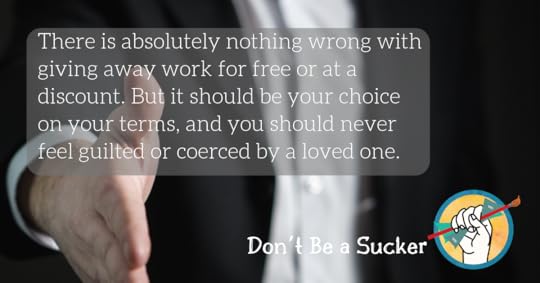
Signs your friends and family are taking advantage of you as an artist
Friends and family members of artists are notoriously bad at honoring reasonable professional boundaries. For anyone who is not an artist, it is difficult to fathom why a simple painting can command such high prices. It’s just a painting. Of course, artists know that what they’re truly selling is not the single painting. They’re selling the hours, weeks, months, and years of practice, effort, and learning that resulted in the ability to produce that painting. There may have been literal blood, sweat, and tears involved in the production of the art that seems, on the surface, so simple.
Only those with an extreme lack of self-awareness would dare to ask a real estate agent, an insurance salesman, or an electrician for free or heavily discounted work, even if they were a relative. Why? It’s much easier and perhaps more culturally acceptable to recognize the years of schooling and hard work that go into the formation of these professions.
And it’s also worth noting- there is absolutely nothing wrong with giving away work for free or at a discount. But it should be your choice on your terms, and you should never feel guilted or coerced by a loved one. Here are a few indicators that the transaction isn’t as healthy as it should be:
You begin to feel resentful for the time and effort it’s requiring versus how much you’re being paid
You’re worried that you won’t be left with enough time or resources to devote to better paying work
The work is outside of your niche and it’s not bringing you fulfillment or joy
You’re afraid to say “no” because of an impending guilt trip
Another variation of this risk (we wouldn’t call this one a scam) is organizations, particularly nonprofits, who solicit free art for events, fundraisers, silent auctions, etc. These organizations will often make promises of “exposure” and new sales, but these promises rarely materialize. There is nothing wrong with deciding to donate your art to a fundraiser- but it’s wisest to consider that piece of art as a total loss rather than an investment.
Smarter alternatives
So what’s the solution? You don’t have to be a jerk in order to prevent others from taking advantage of you. In fact, you may want to compose a series of canned responses you can give whenever a friend or relative asks for heavily discounted or free work, or asks you to create a piece of art outside of the niche you’ve settled on. Then all you have to do is stick to the script. Some examples:
Can I have this piece at a cheaper price/for free? Hey there, I wish I could give every piece away for free because I love to share the joy my art brings me with the world! Unfortunately, this is a significant part of my livelihood and in order to meet my bottom line I’ve got to stick to my stated prices. Thank you for understanding! If you’re looking for something in a lower price range, have you checked out my (3”x5” prints, etc)?
Can you do a portrait of my dog (or something else you don’t want to do)? Your dog is so cute! I can see why you want to preserve his handsome mug in a portrait, and I love that you thought of me. Unfortunately, I’m not your gal. I have spent the past several years working on my (botanical illustrations) and I don’t think I would be able to do your little guy justice. Can I recommend you to my friend who does pet portraits exclusively?
I don’t want you to sell prints of the commission you’re doing for me. That way it will be more valuable and unique. Actually, there’s not always much overlap between those who buy prints and those who buy and commission original art. So selling prints of the work is very unlikely to devalue the original piece. If you’re very serious about exclusivity, I’d be happy to draw up a contract for you to reflect the terms as well as the 3x price increase that is standard to exclusivity.
Here’s what we want you to take away from this piece: you can be a beautiful, sensitive soul who sees the world through your unique artistic lens, and you still don’t have to be a sucker. Take some time to educate yourself on common scams, and as you grow your business be sure to keep both eyes wide open. Be aware that growing your art business takes time- usually years and years. This is normal and healthy, as impatient as it can make you feel. Any opportunity that promises to skyrocket you to fame or pay you radically more than you’re accustomed to should be met with slow and careful skepticism. Ask plenty of questions, do your research, and be sure to calculate the risks whenever you enter into a new or questionable transaction.
If you’ve read to the end of this piece and you realize that you may need a little help to grow the firm backbone that will be essential to protecting your business, we highly recommend joining a community of professional artists who will support you, compare notes, and help you avoid being taken advantage of. That’s a huge part of why we created The Abundant Artist Association. Learn more here: https://theabundantartist.com/association-v2/
The post Don’t Be a Sucker appeared first on Online Marketing for Artists.
May 29, 2019
Member of the Week: Daisy Faith, from Actor to Artist
This week’s featured Association member is Daisy Faith.
TAA: How would you describe your art to your ideal collector?
Daisy: My art is colorful, joyful and whimsical. I love painting animals with flower crowns that make you smile, colorful beach scapes and I’m happy to take on commissions for collectors who have a sense of eclecticism and humor.
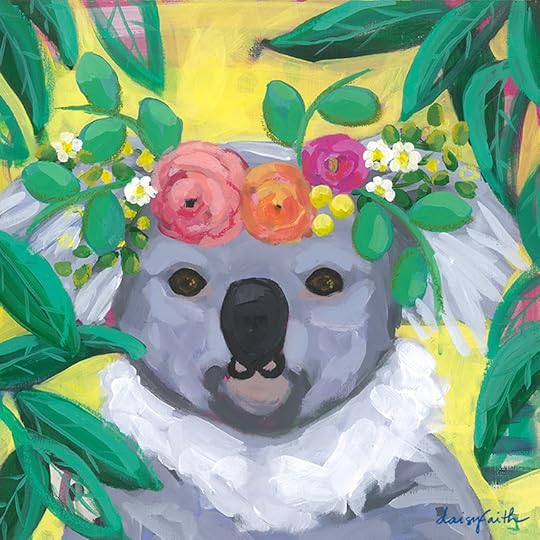
“Zoe Kravitz”, Daisy Faith
TAA: What motivates you during slow seasons?
Daisy: I’m always working so I don’t know if anything is ever slow. If I’m not busy selling I’m busy planning and scheming up new ideas and concepts.
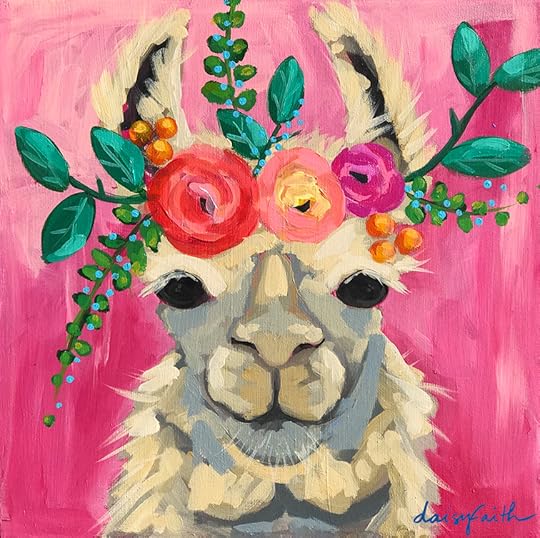
“Lisa Kudrow”, Daisy Faith
TAA: How did you settle on your current way of working?
Daisy: I think it’s just been a process. I was trained to paint photo realistically in college so it’s been a constant un-learning and testing styles since then to come up with something I like. I think the constant is colorful and joyful paintings that are fun to create.
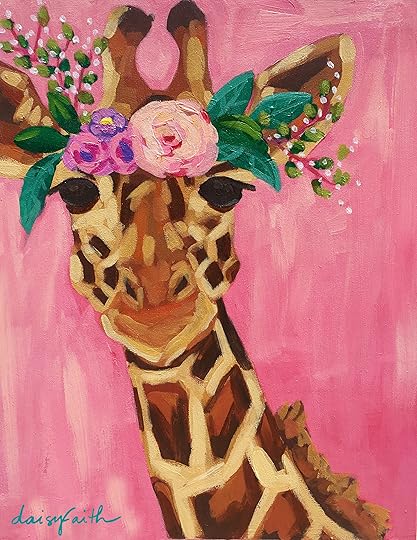
“Amy Adams”, Daisy Faith
TAA: What is one mistake you’ve learned an important lesson from in your business?
Daisy: I think not starting on social media earlier and not trusting my talent. I feel like I wasted some time but in retrospect I do have a lot of other experience in other areas that I bring to my art so it’s never wasted. Also, no focusing enough on one thing like a subject matter.
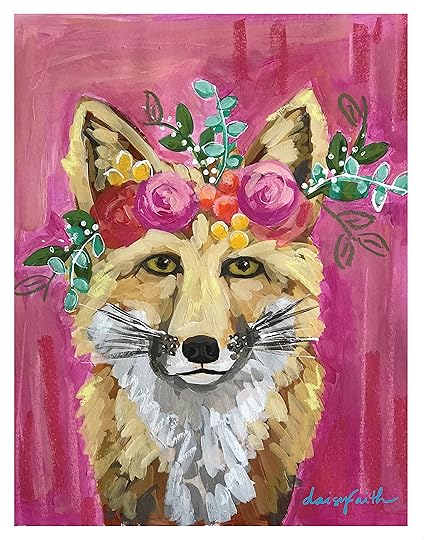
“Blake Lively”, Daisy Faith
TAA: What was your greatest success from the past year?
Daisy: I run a very successful paint and sip businesses so that’s been a joy to watch grow. With my personal painting business I’ve had tremendous growth in connected with my audience and selling pieces online.
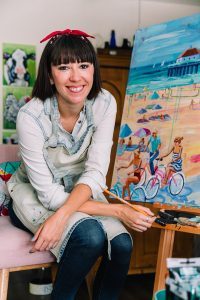
Hi, I’m Daisy! Painter, color lover and striped shirt collector!
I didn’t always own a paint and sip business and sell my paintings. In fact for ten years I pursued a career in Hollywood as an actor. I made it onto the boob tube a few times and it was AWESOME… until it wasn’t enough anymore. I wanted to change my life but the problem was I had graduated college well over a decade ago and had never really used my degree in Interior Design or Art professionally.
I was a thirty-something unemployed former actor with no marketable skills. And then a lightbulb went off! What if my lifelong hobby of painting could somehow become a job? I’d always had a dream of being a successful painter but somehow in my weird brain pursuing an acting career in Hollywood seemed more realistic. I was delusional!
So 3 years ago I started working at the local paint and sip studio as a teacher which made me fall in love with teaching others how to get their creative juices flowing. As of now I can proudly say that I’ve been the owner, operator and lead teacher for over a year now. Today you can find me creating in my Redondo Beach studio with my cutie red beagle pup and enjoying a cup of hot tea (even on warm day) dreaming of color, stripes and all things beachy.
See more of Daisy’s work here: http://daisyfaithart.com
The post Member of the Week: Daisy Faith, from Actor to Artist appeared first on Online Marketing for Artists.
May 22, 2019
Member of the Week: Catherine Bruce, Seeking Synchronicity
This week’s featured Association member is Catherine Bruce.
TAA: How would you describe your art to your ideal collector?
Catherine: In search of synchronicity, I create painting-like photographs using 35mm film, multiple exposure techniques, and a simple Pentax K1000 film camera. I shoot all my images on film and do very minimal to no digital processing. What you see is exactly what is on the film frame.
I see 35mm film as my canvas; a Pentax K1000, my brush; this beautiful earth, my inspiration.
On my website I offer open edition fine art inkjet prints and latex posters.

TAA: What motivates you during slow seasons?
Catherine: Hunger and homelessness are very good motivators.

TAA: How did you settle on your current way of working?
Catherine: I began taking photos this way about 15 years ago. Before that I was a classical photographer.
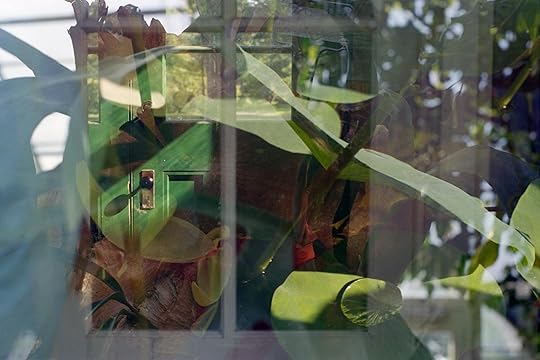
TAA: What is one mistake you’ve learned an important lesson from in your business?
Catherine: My biggest lesson is time management. I wasted many hours trying to setup my website only to have my web developer fix my mistakes. I could have been focusing on tasks I can do and giving my developer the tasks I cannot.

TAA: What was your greatest success from the past year?
Launching my website is my biggest reward for this year.
 Catherine creates paintings with 35mm film, a Pentax K1000, and in camera multiple exposures methods. She shoot at least three photographs on every 36 frames on film. Since she photographs with film and all analogue equipment, she doesn’t get to see how the images will look until she develops the film.
Catherine creates paintings with 35mm film, a Pentax K1000, and in camera multiple exposures methods. She shoot at least three photographs on every 36 frames on film. Since she photographs with film and all analogue equipment, she doesn’t get to see how the images will look until she develops the film.
Catherine’s photo process teaches her to trust her intuition, to stay open to the unexpected, and most importantly, to play. When she does, the results are magical. Even after 14 years of taking photographs in this way, she is still amazed when she discovers synchronicity in her photographs. You can see more of Catherine’s work at http://catherinebruce.com
The post Member of the Week: Catherine Bruce, Seeking Synchronicity appeared first on Online Marketing for Artists.
May 17, 2019
Trusting Yourself with Amica Whincop
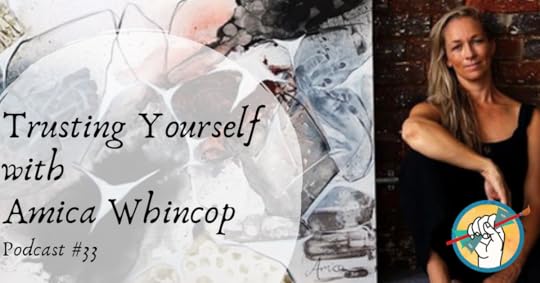
In this episode, we cover:
2:58- How growing up on an island contributed to Amica’s creativity and how she views the world
4:30- Amica shares about her journey from creating “safe” predictable work to make walls pretty to venturing out into creating her own new work
9:25- The catalyst that encouraged Amica to start sharing her new original work with the world
15:08- What Amica’s daily work routine looks like, including how she documents her process and the program she uses to catalog her artwork and upload it to her website
20:55- How Amica tells the story of each piece on her blog, social media, and newsletter
21:36- What Amica’s listening to in her studio
24:00- How Amica promotes her business, and how she transitioned from selling in galleries to selling her art herself
34:55- How Amica came across some of the unconventional tools and methods that she uses to make her art
37:20- How Amica writes her social media posts and newsletter in a way that engages her audience, and why she doesn’t explicitly ask for sales
41:58- What Amica is working on next
Resources:
Steal Like an Artist* by Austin Kleon
*affiliate link
The post Trusting Yourself with Amica Whincop appeared first on Online Marketing for Artists.
May 15, 2019
Member of the Week: Milessa
This week’s featured Association member is Milessa Murphy, who in her art simply goes by Milessa.
TAA: How would you describe your art to your ideal collector?
Milessa: Most of them are educated professionals who need some humor and color in their life and who either connect with my quirky nature or want to understand it (like I’m their muse).
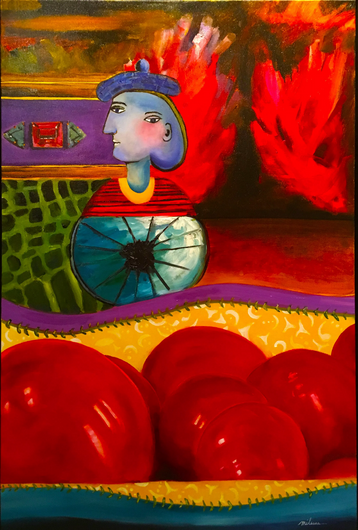
Playing with Picasso, Milessa
TAA: What motivates you during slow seasons?
Milessa: Funny…but Christmas music and/or Christmas movies…it’s my happy place.
TAA: How did you settle on your current way of working?
Milessa: If one stays true and doesn’t allow motivation to be what is “cool” at the moment, it will happen organically. I paint over 40 hours per week, every week, even on most vacations, as I take my paint gear with me.
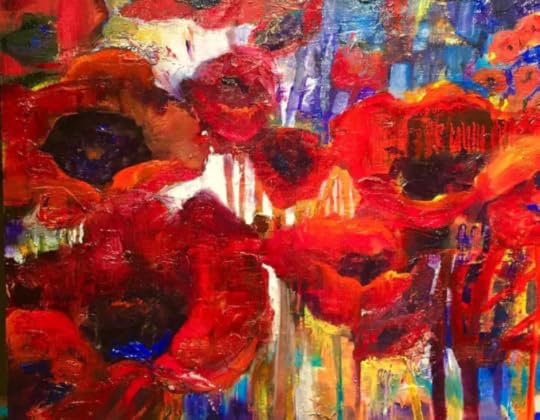
My Love of Poppies, Milessa
TAA: What is one mistake you’ve learned an important lesson from in your business?
Milessa: Not getting my BFA when I was younger. Even though I am a serial entrepreneur, owning 5 successful business, all dealing with creativity, I believe that had I received a higher education, my success as a painter would have happened sooner. Being self-taught, really is not a true statement, as no one really is only “self” taught. Everything you read about art, every art workshop you take, every video you watch and every museum you visit is an education. It takes much longer to become the painter you strive to be, without the formal education. Don’t get me wrong, it can be done, it just takes longer.
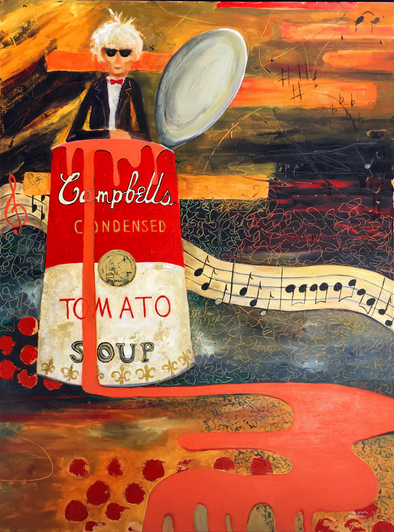
M’mmm Good, Milessa
TAA: What was your greatest success from the past year?
Exhibiting at ArtExpo NYC, where I sold 5 pieces and made some very good contacts. But, also, in mentoring a high school student who doesn’t know if she wants to get her Med degree or an Art degree.
 Milessa is an intuitive painter. It’s her ongoing collection of experiences, apropos of everything up until now; transporting her viewers into a colorful, energetic and happy place. This is her calling! Being your own curator and collector of her art gives you a unique style that others will not have but want. Not to mention, her art will inspire thought and questions, engaging the viewer to think and learn about the subject matter. It certainly will kick start a worthwhile dialogue between anyone enjoying it. You can see more of her work at http://milessa.com
Milessa is an intuitive painter. It’s her ongoing collection of experiences, apropos of everything up until now; transporting her viewers into a colorful, energetic and happy place. This is her calling! Being your own curator and collector of her art gives you a unique style that others will not have but want. Not to mention, her art will inspire thought and questions, engaging the viewer to think and learn about the subject matter. It certainly will kick start a worthwhile dialogue between anyone enjoying it. You can see more of her work at http://milessa.com
The post Member of the Week: Milessa appeared first on Online Marketing for Artists.
May 8, 2019
Member of the Week: Catherine Kennedy, Color Perception and Ocean Waves
This week’s featured Association member is Catherine Kennedy.
TAA: How would you describe your art to your ideal collector?
Catherine: My ideal collector is someone who believes art can enhance a space and give a sense of escapism or bring back memories of time well spent somewhere either in the South West or on an exotic holiday. A person who is interested in local artists in Devon and local art generally, with an interested in travel, lifestyle and interior design. My collector persona is someone with disposable income, a self-starter with a creative background or an appreciation of creativity. Someone with a new home, holiday home or second home with blank walls. Somebody who likes the sea or lives by the sea or has a seafaring past. I have sold to customers who are single but it is usually couples. My ideal collector is happy to use the Internet and buy through my website, a direct visitor is best.
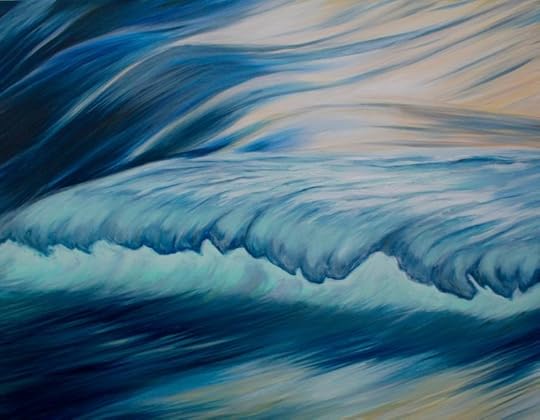
“Into the Blue Ocean Waves”, Catherine Kennedy
TAA: What motivates you during slow seasons?
Catherine: The comments from past customers, for example “Thank you for my painting, it arrived safely and thought you might like to know I have hung it in my bedroom so it is the last thing I see when I go to bed and the first thing I see when I wake. I’m thrilled.”

“Turquoise Seascape”, Catherine Kennedy
TAA: How did you settle on your current way of working?
Catherine: Seeing what works best and what is popular but with enough space for experimentation. I have been painting a series of wave paintings for over 5 years now. It is the light coming through the waves and ever-changing colour of the sea that I am keen to explore. Everyone sees colour in a slightly different way to one another, call it colour perception. The way I see colour and the feelings I get when the colours align well on a canvas is what appeals to me. The way collectors see my work will be unique to them because of their own individual colour perception. Painting from an early age it wasn’t until I reached my mid 30’s that I went to art school, graduating with a BA (Hons) in Fine Art in 2008 at the University of Plymouth. Studying film and video art at university has impacted the way I paint. I like to include a sense of movement in my work and a sense of escapism. I want the viewer to feel they can walk across the sand or dive into a turquoise sea.

“Ocean Wave”, Catherine Kennedy
TAA: What is one mistake you’ve learned an important lesson from in your business?
Catherine: Research galleries that want to take your work. Keep in touch with them regularly. Change over work so that their collection stays fresh. Pick up work if it hasn’t sold with them.
Research exhibition opportunities and make sure before you commit that the curator is organized.
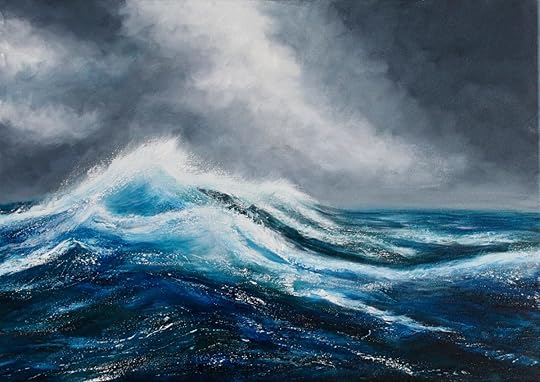
“A Break in the Clouds”, Catherine Kennedy
TAA: What was your greatest success from the past year?
Catherine: A commission for a very large wave painting. The newly married couple had just purchased a modern house and needed a bold painting for their stairwell. They emailed me these comments along with a photo of the painting in situ.
“We’ve moved into a new but rather plain house in Torquay and need a bold painting up the entrance stairs. Thanks for the certificate and for showing me your other work. I’m sure I’ll be back for another.”

Catherine graduated with a BA (Hons) in Fine Art in 2008 at the University of Plymouth. She has exhibited her paintings throughout Devon and gained an award at the Exeter Short Film festival. Her films and photographs have been exhibited on the South Bank, London and in Italy. She has recently been given ambassador artist status for the UNESCO Torbay Geopark. See more of her work at https://catherinekennedy.co.uk/
More Member of the Week features:
Chelsea Lang, Painting the Joy and Light of the Outdoors
Nina Bonos, Painting Vibrant, Sacred Forces
Marcela Diaz, Symbolic Art to Awaken the Soul
The post Member of the Week: Catherine Kennedy, Color Perception and Ocean Waves appeared first on Online Marketing for Artists.
May 1, 2019
Member of the Week: Ruth Collis, A Secret Belief for Success
Each week TAA features a member of The Abundant Artist Association. This week’s featured member is Ruth Collis- check out her story and her work for some great inspiration!
How would you describe your art to your ideal collector?
I found great fascination the day I discovered cake decorating tips on the end of a paint tube in the art supply store long ago, and have since been able to make highly 3-dimensional acrylic sculptured coral and floral paintings with thick paint and pastry tips.
What motivates you during slow seasons?
When you keep your inspirations full, it is never slow. Inspirations create new things that customers will want. One of my inspirations is looking at the design of fine homes around me and how to incorporate that in my paintings, or the sea life and rock textures around.
Another thing I do for endless work and income is turn all the footage of my paintings and secrets discovered, into a video course or quick tutorial for students. There’s always the list of endless ideas I keep recording too.
How did you settle on your current way of working?
It was my dream to madly study how to make a strip of paint dry on a non-stick surface back before many ways became popular. If I could figure out what that could be, then I could peel the dried strip of paint off & form a rose made entirely out of paint, then put it with others in a painting & would amaze people on what is possible with paint alone! This discovery brought about my style of using a “Separate Drying Layer” to sculpt many paint forms!
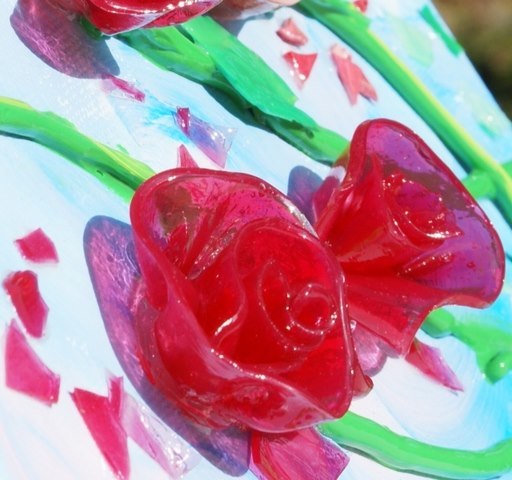
Gel Roses, Ruth Collis
What is one mistake you’ve learned an important lesson from in your business?
To have a commission contract. I spent 3 months making a highly dimensional piece and working out all the kinks for the prospect to not put her money where her mouth was.
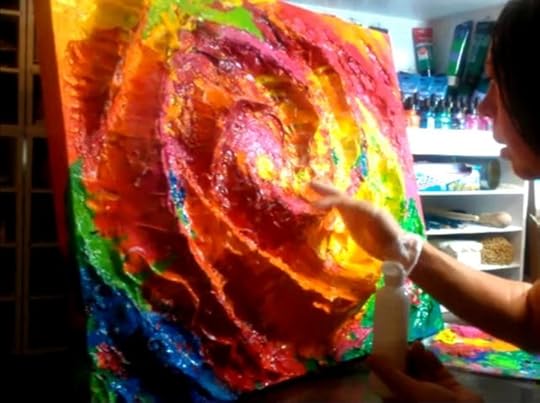
Energy, Ruth Collis
Instead of seeing it as 3 months of my life just wasted, it was also another example of how you learn the most from your most challenging pieces. This one revealed how I can get MUCH more sculpted height by adding already dried paint than waiting endlessly for layers & layers of wet paint to dry. I keep a growing supply of already dried paint scraps to sculpt with called the “Paint Scrap Junkyard” that turned out to not waste paint in our landfills and I also invented a way to evaporate water out of used paint water to prevent paint particle buildup in plumbing over time.
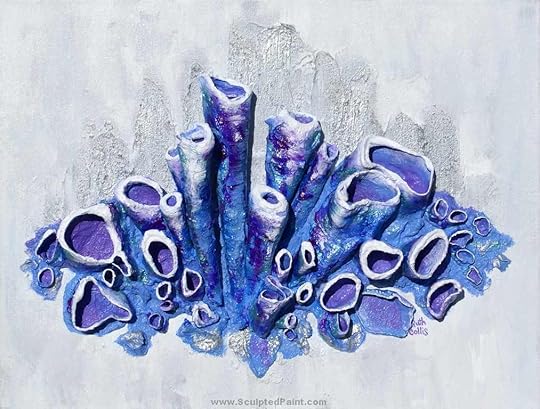
3D Pipe Coral Abstract, Ruth Collis
Video showing it Rotating: https://www.youtube.com/watch?v=02A6d3P5XHs&t=31s
This led to another use for my layers of palette paint… when using a non-stick surface, that enabled whole thick skins of paint to be peeled off & rolled into a pipe coral shape which made the classiest sculpture, and turning it into an online video course has enrolled over 3,184 students.
What was your greatest success from the past year?
My greatest success interestingly has nothing to do with art at all, that people seem to care the least about, but this secret has given me the most success in all areas of my life. It is using Intentional Imagining for what I did want when that didn’t exist yet. It was learning about a universal law of feeling and focus that says, “What you focus on with intent and great feeling, you attract more of that thing in your life.” I am still making myself aware of turning my negative focus into how I do want life to be, but through learning and applying a lot of extra tricks, I have been able to turn a miserable life around to one of my dreams…
Prison cell of a room into freedom of having my own apartment
Noise everywhere into peace & quiet
Scorching environment to pleasant living and by the beach!
Graffiti, trash, & stinky oil spills to living in breathtaking scenery of inspiration
Always feeling out of place to finding I fit much better in the world I created
Unhappy relationships into better fitting ones
Resistance into support
Debt into freedom & high credit score
My own art on the walls where I live for once and turned my own apartment into my own studio and gallery
Hassle of car rentals every time I wanted to go out, to having gas saving vehicles of my own to greet people in, and ability to transport my bigger art to events now
My whole life has turned around from using this Intentional Imagining. “Our thoughts become our eventual reality” is so true and when one takes responsibility for what happens in their world, only then the power changes to be on your hands. I have gone from homeless to relying on myself the more I learn from these principles that has given me the greatest of art success and ability to move to the place of my dreams in Pismo Beach, California where I hope to share these phenomenal 3-dimensional discoveries, and build art exhibits and gardens for touring.
Some additional insights I would add:
See calamity as success.
A thief stole $12,000 I borrowed yet never delivered the tiny home. This led me to a debt elimination program where I owe nothing now, and I live in a much better dreamy apartment that fits me and with a patio to start my gardens.
My car was wrecked first 5 days of moving to paradise, but that led to a payout and better car.
My shoulder got injured at work that led to much paid time off, a settlement, and big leap into the art career of my dreams.
Keep focus on the dreams realized and not the fears.
Having supportive people around you is part of this, and not those resistant to your ideals as a main focus. Make a vision board and put your dreams up in constant sight, and print your own positive sayings of where you want to be and think of already having that, and it will eventually happen.
Always add to your education.
Invest in yourself and learn from a teacher who is where you want to be with your style of painting that can save you great time; and also invest in good marketing courses to help you get your art out there and noticed in ways you never imagined, like this How To Sell Your Art Online, from The Abundant Artist.
 Ruth Collis offers originals available for purchase on her website and online instruction for students. She has been painting since 1998 and finds inspiration in fun tools like cake decorating tips to get highly sculpted forms in thick paint easily. She has many paint inventions for our time in history, and her continual testing reveals new discoveries she shares in her instructional video courses since 2014. She has authored many books, and now sells originals to homeowners and businesses. She is an international artist and has started the beginning stages of building her Art & Gardens for tours in her inspiring town of Pismo Beach, California and the surrounding area of where she lives. You can see her art at http://www.SculptedPaint.com
Ruth Collis offers originals available for purchase on her website and online instruction for students. She has been painting since 1998 and finds inspiration in fun tools like cake decorating tips to get highly sculpted forms in thick paint easily. She has many paint inventions for our time in history, and her continual testing reveals new discoveries she shares in her instructional video courses since 2014. She has authored many books, and now sells originals to homeowners and businesses. She is an international artist and has started the beginning stages of building her Art & Gardens for tours in her inspiring town of Pismo Beach, California and the surrounding area of where she lives. You can see her art at http://www.SculptedPaint.com
More Member of the Week Features
Marianne Goodell: Figurative, symbolic art and jewelry
Bart Levy: Impressionist landscapes
The post Member of the Week: Ruth Collis, A Secret Belief for Success appeared first on Online Marketing for Artists.
April 24, 2019
The Science of Creativity
The Science of Creativity
Many people think of creativity as a zero-sum game—either you have it or you don’t. However, science has shown that not only are we all capable of being highly creative, but there are also many ways to improve our creative abilities. Best of all, it isn’t that hard to expand our creative mind.

What is creativity?
Creativity can be defined as the ability to link ideas, thoughts and concepts that seem to be entirely unrelated. It is taking existing ideas and connecting or combining them in such a way other people would not have considered.
What can prevent creativity?
According to apa.org, excessive stress is one of the best ways to kill creativity. Our minds work best when they are calm and relaxed.
Work creativity like a muscle
Just like with your body, when you exercise your creativity, you can only improve it. Make it into a routine so that it becomes a habit and you will see your productivity increase.
Research shows that the more you use your brain to do anything, connections between the involved cells only become stronger.
Give yourself more time to actively think. If you unplug yourself from social media, the internet and your phone, you will give yourself more time for ideas to flourish. Try to avoid taking gadgets like your phone to bed.
Set aside a time of day for creativity. It will get you in the frame of mind for a big brainstorming session.
How to start getting in the habit of creative thinking
Write down your new ideas
To create new ideas, you need to be able to connect existing ones into new combinations. The best way to do this is to get a notebook, an app on your computer or phone or even note cards to write your thoughts down.
The next step is to analyze your ideas. Try to see them from a fresh perspective and where there might be a relationship or connection between them.
Allow your subconscious to play with the ideas until you have a moment of insight. Once you do, you can flesh out your idea and build on it.
Broaden your knowledge

If you take classes or read about things that are outside of your expertise, you increase your ability to engage in the divergent thinking that leads to creativity. You can find plenty of free college courses online and classes in a variety of creative outlets like fabric and hardware stores.
It may not seem like what you have learned will be entirely useful at first, but new ideas come from connections with old ideas. Those new pieces of information you are learning may come in handy in a future brainstorming session or challenge in the future.
Surround yourself with interesting company
Research shows that collaborating and interacting with others who are also intelligent and creative can help your creativity grow as well.
Challenge yourself
Trying new things tends to make you more creative. You could brainstorm solutions to things that don’t necessarily have an answer (such as making a dog fly) or learn a new skill such as jewelry-making or taking on a new language. Brainstorming exercises the mind while mastering a new skill not only brings a sense of satisfaction, it can also relax you so that you get more of those “aha” moments.
Meditate later
Meditation and mindfulness are healthy exercises to reduce stress, but you may want to practice them later if you want to have a brainstorming session. Mindfulness is all about the here and now and stops the busy “thought traffic” we typically have.
That “thought traffic” is essential to creative thinking. You need random thoughts to engage with other random thoughts to inspire you. This is where you need to daydream or jump in the shower and let your mind wander.
It’s all in your head
An interesting study researched the placebo effect on creativity. Two groups were given a strong smell such as cinnamon to sniff before they performed on a typical test requiring creativity. One was told that it would improve their performance. The other group was not told that it would make any difference.
The group that was told that the smell would help them performed much better on their test. This means that the more you believe you are creative, the more likely you will have creative thoughts. You need a positive attitude to think of great ideas.
Change up your surroundings
Research supports that even the most minimal changes in your surroundings can promote creativity. They can be as small as different colors in your room or taking your coffee black if you usually mix something in.
Change your physical surroundings as well as your social ones. If you see the same things on your wall and desk and are talking to the same people, that may not really help inspiration to strike.
Take a nap

Sleeping flushes out a chemical in the brain called adenosine, which makes you feel tired. But having a power nap in the afternoon does more than give you more energy. Did you know that having coffee before your afternoon nap can improve your creativity?
Caffeine takes about 20 minutes to start working, so you drink that cup before your power nap and you will have sharpened memory performance. And for the creative process, memory is essential.
Other ways to increase creativity
Make sure you get enough sleep and pay attention to your health.
Get outside when you want to open your mind or at least let the sunshine in your house or office. Direct sunlight and natural wood are best.
Collaborate with others on projects and brainstorming sessions.
Maintain a lifestyle that keeps you in a happy mood. Studies show that sadness inhibits creativity .
Get some solitude. Introspection can make creativity thrive when you can process information and make connections without interruption.
When you collaborate, do it in writing. Group brainstorming sessions aren’t as successful as they could be because people often fear the rejection of their ideas. However, putting it in writing is less stressful and leads to the ability to build off other people’s ideas, leading to more innovative thinking.
Final thoughts
As you can see, there are many ways to increase your creativity. Keeping a positive attitude, avoiding stress and keeping happy can all help. However, you will really want to believe in yourself and your creative abilities to succeed.
Use these researched tips to keep your creativity going and exercise it like you would your body. Try new things and keep yourself challenged and you will see great results!

Brenda Kimble is a writer and stay-at-home mother of two daughters and a son, plus their beagle named Duke! She loves blogging, crafting, and spending time with her family. She also enjoys strolling the streets of her quaint neighborhood in Austin, Texas and finding the trendiest hotspots for fashion, food, and live music.
The post The Science of Creativity appeared first on Online Marketing for Artists.
April 19, 2019
What Are Your Collectors Thinking? The Customer Journey
I’m an art collector. Well, no. I fantasize about being an art collector. In my imagination, where I drink a highball every day at five o’clock sharp and go on long vacations to places where the temperature never dips below 70, I’m an art collector. I love art, but I’ve never plucked up the courage to buy much more than a small print here and there, and the long hours I’ve committed to my job don’t give me a lot of wiggle room for learning about art. It’s intimidating.
But in spite of being generally intimidated by the art scene, I’m attending my first First Friday art walk. It’s about time I actually left work on time and took a breather, so I’m strolling downtown with a craft beer in hand, squinting into the glaring late-spring sunset. I look at your display for a few seconds as I stroll past. My smile is friendly but cool, and combined with my mirrored aviators it’s intended to dissuade you, a mysterious artist type, from talking to me. Your display is simple but to the point- I can tell that you do rural farm paintings, and they have an ethereal quality that is enchanting to me. My eyes settle on one piece in particular, a farmhouse in a misty-looking field, and the way you’ve painted the light streaming through the woods! I’m a little surprised that I can’t stop thinking about it. The colors are dreamy and make me feel something warm and safe and optimistic that I don’t think I’ve felt since I was a kid.
I continue down the sidewalk, still thinking about that painting. But, I reason to myself, I’m not really here to buy- I’m intimidated by buying art. That’s something snobby pretentious people do. I’m just here to have a beer, blow off some steam from a 60-hour work week and look at all the pretty pictures. There’s no shortage of charming dog portraits, caricatures drawn on the spot, and highly-detailed pencil drawings of celebrities. They’re all well and good, but something about that farm painting stays in the back of my mind and niggles at me.
I’ve finished my beer and walked the length of the promenade, and finally decide to pay your table one last visit. Sure enough, that gorgeous painting is still sitting there. It’s not huge, about 9×12, but the more I look at it the more I picture it on the wall of my kitchen, next to a photo of Great Grandma. She lived in a modest little yellow farmhouse not unlike the one in the painting. She would let me help her make snickerdoodles and gather the eggs from the chicken coop when I was a little girl visiting her during the long summer breaks. The warm and loving impressions from those early memories are planted deep in my heart.
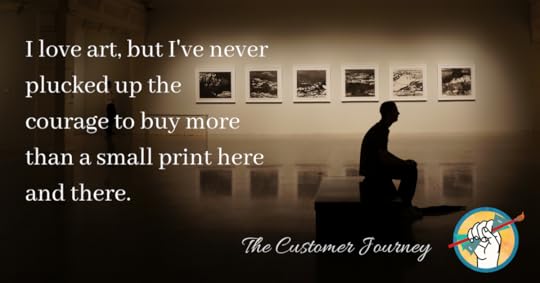
You have obviously noticed me staring at the painting for far longer than a casual observer would. I’m feeling a little embarrassed, but your smile is warm and understanding.
“I painted that one after my dad died,” you say, “He grew up on a farm up in the Pacific Northwest, and he had this thing where he would say the sunlight on the farm shone through the trees like it was coming straight out of heaven. He was a bit of a romantic!”
“It reminds me so much of the farmhouse where my great-grandma used to live!” I reply. “I kinda keep picturing it in my kitchen.”
I burst out in an awkward laugh. I want this painting. But… that’s a lot of money for a pretty picture, isn’t it?
You whip out an iPad and before I know it, we’re looking at the same painting hanging in a warm living room above a huge fireplace, then in the corner of an all-white room with a grand piano, and then on the wall of a cozy modern kitchen.
“That one looks really similar to my kitchen,” I say, and I can already tell that I’m in love with how it looks above the rich wood paneling on the wall. It looks an awful lot like my own kitchen.
I swipe my card through the Square reader before I can talk myself out of it, and I’m a little giddy with excitement- like I actually have butterflies in my stomach. I go ahead and opt-in when the app asks me if you can send me emails in the future. I’m not really interested in an artist newsletter, but your work evoked such big emotions in me at just a glance, I think I’d be happy to see more of it. You send me home with the painting, a postcard, and a warm handshake.
Sure enough, the painting finds a perfect spot on the wall next to the portrait of Great Grandma. Now every time I walk into the kitchen I’m drifting away remembering those long summer evenings: the chirping of the crickets, stargazing in the backyard, that particular sweet-and-sour farm smell wafting by on the warm breeze.
Oh my word, I think, this painting is literally magic.
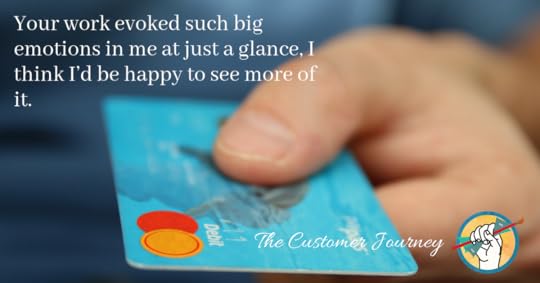
I start receiving occasional emails from you. They’re not salesy at all, which surprises me. Instead you tell stories about the individual paintings: how your dog shook himself against this one and left a scattering of shed hair against the drying paint that you had to painstakingly pick off with tweezers, or how another painting sat in the corner of your studio for three months before a particular shortcut home through a dumpster-lined alleyway, of all things, had you so inspired that you had to rush home and finish it immediately. I expected that you would just be trying to advertise to me, but I find myself liking you more and more as a person. Your writing is a little funny, and you’re very transparent about the surprisingly unglamorous life of a working artist. It’s so outside of my realm of understanding that I never would have expected it, and yet here we are, connected somehow through the love and memories you evoked in me by your work.
I’m also surprised by how much I enjoy the work-in-progress photos. I’m not really a creative type, although I play the guitar a little when I’m not working. But it’s fascinating to see what goes into producing one of your finished works- saving inspiration on a Pinterest board, the pencil sketches, the color studies, the underpainting. Terms like “color study” are completely new to me and it’s a little thrilling to be allowed into your secret world.
Several months in to receiving weekly emails from you, you link to an album of work-in-progress photos on your Facebook page. I click through and like your page. I am not on social media a ton, but I do notice that you like to share when happy collectors post pictures of your work. Hey… I’m a happy collector too! I snap a picture of the painting the next time I’m in the kitchen, and post it on Facebook. I tag you and also my mom and my brother: “I can’t believe how much this painting looks like Great Grandma’s farm! So happy to have it hanging right next to her. Sweet memories. 
March 28, 2019
Case Study: Jessica Singerman
Association member Jessica Singerman recently quit her day job to focus on pursuing her art full-time! Woohoo! We sat down to learn more about Jessica’s trajectory: how she arrived from art school to quitting her day job, and what lessons other artists can learn from her experience.
Of her trajectory from art school to quitting her day job to create art full time, Jessica says it was “not linear.”
“I finished my MFA at University of Delaware in 2004 and I had been teaching while I was in school.
I kept teaching, so I was teaching art at University of Delaware and the community college as an adjunct in New Jersey. I was doing the adjunct thing and I was also working at a bike shop.
I was painting, but kind of inconsistently. I didn’t know what I was doing with my life after grad school. I would say the first few years out of graduate school I did not know what I was doing.”
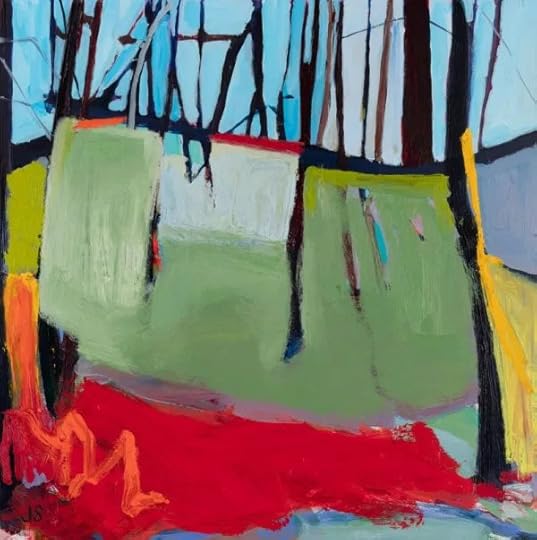 “Pilot Mountain 6”, Jessica Singerman
“Pilot Mountain 6”, Jessica Singerman
It wasn’t just the sense of uncertainty about the way forward that was an obstacle to Jessica’s success at first. She shares that her understanding about the way that inspiration functions for the working artist was preventing her from making regular work:
“I had this misconception that you will work when you’re inspired. And now I know that that’s really far from the truth. You just work. You put the work in, and then inspiration comes.”
It wasn’t until her son was born and she experienced a crisis of identity that Jessica discovered how to incorporate a daily art practice into her life. She also found that this profoundly alleviated the symptoms of depression and anxiety.
 “The Airplane Painting”, Jessica Singerman
“The Airplane Painting”, Jessica Singerman“I set this goal to do a daily project. I would do a project in one sitting, usually when my son was taking a nap, and I started hanging on to this for dear life. I did that for a few months. We were living in Australia at the time, so I didn’t have a studio. My studio was like the contents of a little box. I learned really quickly that I had to make my work space easy to access, and my projects quick to get into with no clean up. I wasn’t using oil paints at the time, I was using watercolors and inks and drawing. Everything was quick to set up and take down.”
Jessica has fallen into a new rhythm since that time. She is still somewhat beholden to her son’s schedule, but most often she chooses to make work first thing in the morning while her “critical brain is off”. It was those early days of motherhood that taught her the importance of making art everyday. Around the time her son was one, she met a fellow artist through a life drawing class who referred her to a gallery in Charlotte. The gallery took her on, which Jessica described as “very validating.” In the end the gallery didn’t work out, however, and Jessica had to flounder a bit before finding new representation that was a better fit. She says of her current situation:
“I’ve got this gallery in Charlotte which is a great fit. The owner trusts me, and she’s willing to take chances on my work, so I’m trying something different. I’m doing a big installation and a video projection in March as well as some paintings, to give her something a little more easy to sell. But I really appreciate that she’s willing to take that chance on me.
I also work with a shop in Winston-Salem. It’s a showroom for really high-end hand built furniture, and they also show other local artists there, so it’s a really nice fit. It’s a beautiful space. I also show at university galleries and other nonprofit spaces as well. This year in September I had a show at Salem College, I have some work going in to a faculty exhibit at a beautiful gallery at Winston-Salem State this month and then I’m showing in an architecture firm also next month.”
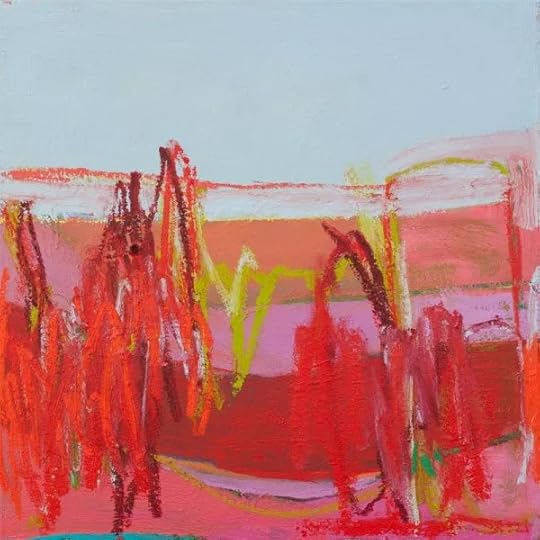 “Birds Content”, Jessica Singerman
“Birds Content”, Jessica SingermanThis is a surprising amount of activity for Jessica, who was not too long ago struggling to make any work at all and feeling adrift between teaching, a full-time job, and trying to make room for her art. When asked how she accomplished her current lineup of representation and ongoing shows, she shared the details of that “non-linear” path that led her here:
“A friend of mine is friends with the owner of the gallery in Charlotte, and had mentioned my work to her. I showed her my work, and the gallery owner actually approached me, which has never happened in my life, and asked if I wanted to show in a three person show last march. That was kind of like a trial.
The shop in Winston-Salem I found through Instagram. Someone who I didn’t even meet but we were following each other, had mentioned my work to their friends who run this shop. So when they opened the shop they asked me if I wanted to show some work there.
The show at Salem College last year, I found out who the contact was and emailed her. I asked her if I could show there, and actually it wasn’t gonna work out for a couple of years, but then all of a sudden she had a hole she needed to fill. The Winston Salem State show is because I taught at Winston Salem State and they’re doing a faculty exhibit.”
[image error]“Autumn Colors Coming”, Jessica Singerman
Perhaps one of the key takeaways from Jessica’s experience is that it’s all about who you know. She’s had the benefit of valuable friends and acquaintances both in day-to-day life and on social media who recognized the quality of her work and shared it with others. So the key? Talk about your work.
The flip-side of that coin is that not only does Jessica talk about her work with people she knows and maintain a good online presence, but she also jumps at opportunities that present themselves.
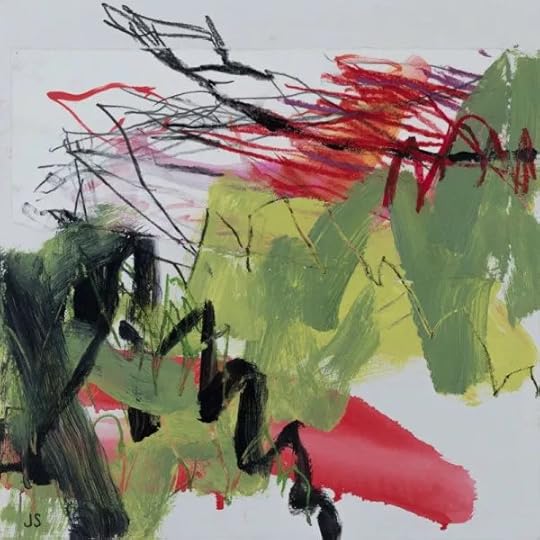 “Forces of Nature 4”, Jessica Singerman
“Forces of Nature 4”, Jessica SingermanJessica also has the unique experience of being an art-world native who has had to find her wings outside of the protective bubble of art school and academia. As she has taken steps to grow her own career both with and without gallery representation, he has encountered elitist attitudes about doing the work of selling her own art:
“It’s ego, you know? You don’t want to look like you’re selling your work, because then it’s like you’re selling out. And it’s such a misconception, because the idea is that the galleries are going to take care of it. But even now, I think it’s expected that you still represent yourself on social media. I have friends who are represented by plenty of galleries and they’re still working it on social media.
So for me, it’s ego. It’s been just swallowing a lot of the misconceptions that- I don’t know that they’re actively taught, but you’re definitely made to feel that if you try so hard to sell your own work, you’re selling out or that you’re not a serious artist. Not a lot of people talk about having day jobs in the art world, because it’s like this dirty word. It’s okay to be a teacher, and it’s okay to have a wealthy partner and not mention it. “
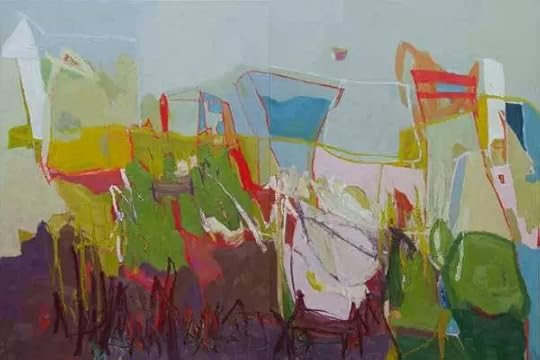 “Light Igniting Fields, Trailing Clouds”, Jessica Singerman
“Light Igniting Fields, Trailing Clouds”, Jessica SingermanJessica’s current focus is on improving her writing, producing more content for her marketing efforts and finding a new rhythm, having recently quit her day job to pursue art full time (way to go, Jessica!)
“My big thing now really is not to overdo it. My natural tendency is to work all the time. And the big thing I want to work on this year is spending more time with my son. With a day job and teaching, I was teaching last semester, and then my art practice and the business, I was not spending what I felt was enough quality time with him and that’s the big thing for me. That’s the big shift. Spending more time with my son. Not overdoing it. Setting boundaries for myself, and not burning the candle at both ends, which I’m really good at.”
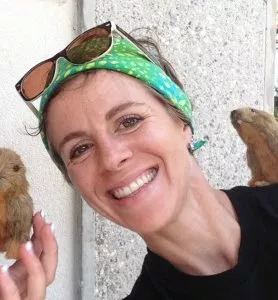 Growing up, Jessica spent a lot of time drawing and making things. Looking back, the experience of making things was and still is the same for her: she is focused; nothing else matters except for what she is making at that moment, and in the best case scenario, she is in a state of flow. This feeling of being in the moment and fully engaged with her environment and what she is doing is similar to her experience when she is enjoying the outdoors. Whether in a forest or on a mountain top, what resonates with her are the feelings of being connected to the world and at the same time, of being small in a vast universe.
Growing up, Jessica spent a lot of time drawing and making things. Looking back, the experience of making things was and still is the same for her: she is focused; nothing else matters except for what she is making at that moment, and in the best case scenario, she is in a state of flow. This feeling of being in the moment and fully engaged with her environment and what she is doing is similar to her experience when she is enjoying the outdoors. Whether in a forest or on a mountain top, what resonates with her are the feelings of being connected to the world and at the same time, of being small in a vast universe.
It’s through making things and being in the outdoors that Jessica is able to connect to the world and to find her place in it. In the outdoors, we are reminded of how small we are in the world. We experience the vastness of the universe and at the same time, the interconnectedness of it all. See more of Jessica’s work at http://jessicasingerman.com
The post Case Study: Jessica Singerman appeared first on Online Marketing for Artists.
The Abundant Artist Goodreads blog
- Cory Huff's profile
- 31 followers





